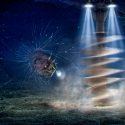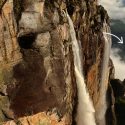If only there were a simple trick to stop a massive volcano from spewing out lava. Like maybe plugging it up with good old concrete. A massive volcanic explosion sends rock, lava and ash everywhere. Fire and destruction are all around you.
If only there were a simple trick to stop an eruption. Like maybe plugging up those magma mountains with good old concrete. How could this wild idea be accomplished? Would concrete be able to withstand the pressure and heat? And would it do the trick or make things even more dangerous?
Concrete is the most used material in the world. With 18 billion metric tonnes (20 billion tons) used every year, you encounter it everywhere. Even the Colosseum was constructed using concrete. That was nearly 2000 years ago, and it’s still around today.
This incredibly durable material is made of gravel, water and a bit of cement. And it only gets stronger with time. The strongest of concretes can withstand the pressure of Challenger Deep, the deepest part of our oceans.
But would it withstand an erupting volcano? Or would it be like extra deadly Mentos and Coca-Cola?
Volcanic eruptions involve a lot of heat and pressure. If we poured concrete into a hot volcanic mouth, surely it would just melt, right?
Not exactly. Concrete has a melting point at about 1,500 °C (2,700 °F). Even the hottest orange lava only reaches 871°C (1,600 °F). But just because it wouldn’t melt doesn’t mean it could work.
Volcanoes erupt when the internal pressure from the magma reaches the point where the ground covering it breaks apart. Eventually, it collapses, and the magma runs free.
The greater the pressure difference between the surface and the magma, the more explosive the volcanic eruption.
So, putting a concrete plug on a volcano would be a dangerous addition. We would be forcing the pressure to build up below the ground. Much higher than it usually would. This would make the inevitable explosion even more energetic.
If the magma were unable to penetrate the concrete, it would explode out of its sides. This is a Vulcanian eruption. This happened in 1980 when Mount St. Helen’s erupted. The pressure build-up was so massive that one of the sides was bulging out into a dome.
The pressure became so great that the dome broke, and the volcano erupted sideways. This powerful explosion ejected material at a velocity of 350 m/s (1,150 ft/s)., Dozens of people died.
Our concrete strategy wouldn’t only end up in a Vulcanian eruption. The concrete plug would burst out too. The dust from concrete would lead to fatal lung diseases and cancer.
The lava flow from a natural eruption is usually slow and predictable. Maybe a better plan would be to use the concrete to divert the flow away from towns and cities.
Like in 1983 when Mount Etna erupted in Italy. The lava flow threatened three towns. Barriers of rock and ash were created to divert it.
The first barrier stood at 18 m (59 ft), and it was quickly overrun. The second barrier kept the lava from traveling further west. So, we could use concrete to form barriers or walls to protect towns and cities. But you probably shouldn’t throw a ton of concrete blocks into the flow and see what happens.
Sources
- “Architecture of the Colosseum | The Colosseum” (2021). Retrieved 22 September 2021.
- “10 Impressive Facts About Concrete – EKA Concrete | Direct Supplier Of Ready Mix And Site Mix Concrete”. 2017. EKA Concrete | Direct Supplier Of Ready Mix And Site Mix Concrete.
- “Everything You Need To Know About Concrete Strength | Cor-Tuf”. Lysett, Tim. 2019. Cor-Tuf UHPC.
- “How do you stop the flow of lava?”. 2014. BBC News.
- “What is the Melting Point Of Concrete? | Bagofconcrete”. 2021. Bagofconcrete.
- “How Hot Is Lava?”. 2010. livescience.com.



























